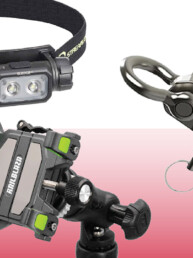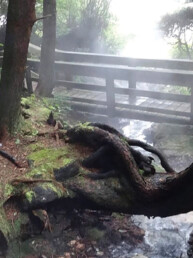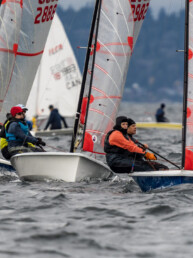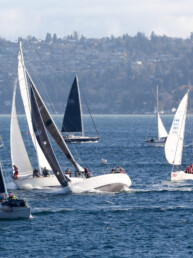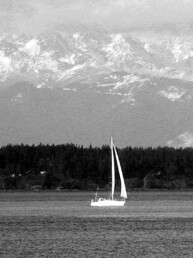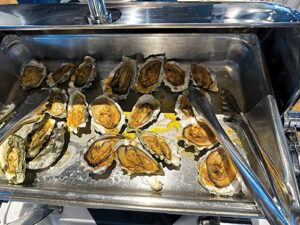
Before I understood how vast the waters of Puget Sound are, I was surprised to see so few boats out during the beautiful summer months in the Pacific Northwest, weekly club races notwithstanding. I was used to a much different sight in the San Francisco Bay Area, where I lived until recently.
Growing up just north of the city, I was amazed by the surfeit of sailboats on any sunny weekend as I crossed the Golden Gate Bridge from Marin to San Francisco. On a clear and breezy afternoon, it seemed possible for a landlubber to travel from the shore of Sausalito to the city’s Ferry Building by hopping from sailboat to sailboat, with nary a splash of salt water landing on his or her Top-Siders.
But once I realized how big Puget Sound is, I understood the dearth of vessels out on the water. It is so big, reports the Encyclopedia of Puget Sound, that if every resident of Seattle was in their own boat on the waters from Admiralty Inlet to Olympia at the same time, there would be about 200 feet between each of them—a comfortable maneuvering distance but an unimaginable distance to be traversed by leaping.
As a former math teacher, I enjoyed playing around with the numbers provided by the encyclopedia, reducing Seattle’s population of around 755,000 to something a little more reasonable for the quantity of vessels that might be on the water at any given time. If the number of boats on Puget Sound was, say, 10,000, I calculated the distance between them at 1,600 feet, more than a quarter of a mile, and I began to understand why I wasn’t seeing a bevy of boats on Commencement Bay. Additionally, I knew that some of those boats would be moored among the marinas and shores of the San Juan Islands or even beyond. Some were perhaps heading up the Inside Passage to Alaska, traveling north for summer as seabirds in flight, with the wind driving their canvas sails rather than avian wings.
Since my wife, Laura, and I have yet to make the trek toward British Columbia, choosing to cruise locally around Commencement Bay rather than challenge the wind and waves of the Strait of Juan de Fuca, we often find ourselves far more than a quarter-mile from the nearest boat. Sometimes it even feels like we have the bay all to ourselves, although I know there are other folks enjoying the spacious waters as well. Like us, they find that an afternoon sailing adventure offers an opportunity for a quick getaway from too much yard work outside or a rising thermometer inside.
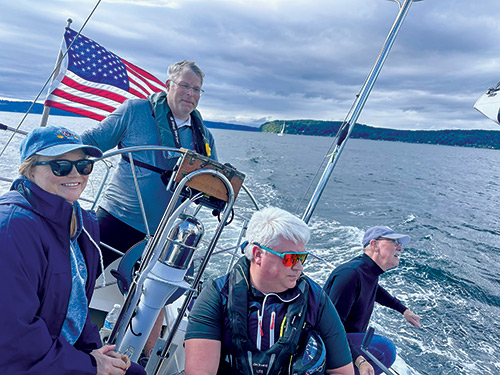
For sailors who may still be reluctant to hoist their mains during the summer months, our club sponsors a “Get Out and Sail Night” every other Thursday from mid-June through August. On those evenings, about half a dozen boats usually depart their berths in the marina to join their fellow dockmates out in the bay. However, on one special summer weeknight, the boats are packed with passengers and crew in anticipation of the post-sailing festivities. What awaits them is a nearly unlimited supply of the famous Hama Hama oysters.
Our club’s sailboat chair procures a large order of the bivalve mollusks from the family-run oyster farm on the western shore of the Hood Canal for this annually anticipated dinner in late June, just before the great boater migration northward. The club restaurant prepares the delectable shellfish with several enticing recipes, making the outing a must-attend event.
Powerboaters in the club will sidle up to sailboat captains, begging to hitch a ride on a wind-powered vessel—a nominal requirement to partake of the post-voyage feast. To be fair, the oysters are a powerful incentive even for sailors, who might otherwise be more likely to spend a warm, sunny afternoon on their cedar back deck at home rather than their teak foredeck on the water.
I am surprised sailors need a carrot (or oyster, in this case) to get out and sail. On the other hand, I am appreciative of the event, which provides camaraderie and solidarity for novice sailors like Laura and me. There is an added excitement when sailboats cut across each other’s path, making a beeline for an imaginary marker in a race with no starting line nor set course.
For a couple of hours on an afternoon in June, while Laura and I crewed Ariel in and around the rest of the “Get Out and Sail” flotilla, I was reminded of the sight of sailboats cruising the waters inside the Golden Gate Bridge, and for an instant, the PNW felt like home.
After leaving the harbor under partly cloudy skies and 10- to 15-knot winds, our Columbia 28 and the rest of the fleet found itself heading northeast toward Brown’s Point, then shifting westward for a short breach into the mouth of Quartermaster Harbor.
While the sight of so many boats reminded me of my time in Northern California, my nostalgic moment was cut short as I quickly shifted my attention back to sail trim and steering, ignoring the size and scope of Puget Sound or the populations of Seattle and San Francisco. With many of our fellow dockmates participating in the evening sail, I had to at least look like I knew what I was doing.
The inconsistent and aggressive 25-knot gusts made for an exciting run across Commencement Bay, with quick tacks and accelerations through the choppy waters at the south end of the East Passage to Seattle.
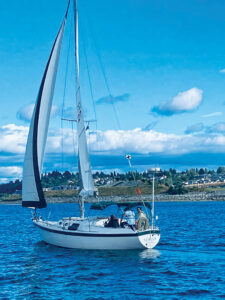
Photo by Patti Poulliot.
Wavewalker, an Ericson 38, cut across our bow, and Nemesis, a Cal 30, deftly maneuvered herself parallel to our path. Her skipper, Fred, who has mentored Laura and I over the past couple of years, occupied his familiar helmsman position, sharing the cockpit with friends and family.
Tom and Renee, another supportive influence in our growth as sailors, confidently steered Barquinho, a Cal 31, among the informal regatta, at times leading the pack. They hosted a group of new sailors from the Tacoma Women’s Sailing Association.
Sail chair Rob, on his C&C 37/40, Xocomil, threatened to outpace us all with only a headsail before hoisting his main. He quickly overtook Welcomed Change, a Jeanneau 40, in an impromptu race. Like others, he hosted about a half-dozen folks on his beautiful vessel.
After a quick hour or two of tacking across the currents of the sound, we found ourselves in a race back to the marina, knowing that the last-place finisher would wind up at the end of the buffet line, surely the greater disappointment of the two outcomes.
After stowing gear and lines as quickly as possible, we all made our way to the clubhouse. The meal did not disappoint, providing a fitting reward for an exciting afternoon on the water. While the oysters provided the incentive, Mother Nature gifted us with the wind and waves to truly enjoy our decision—whether made by design or default—to remain close to home this past summer.
The Hama Hama oyster sail is growing in popularity every year. I even overheard a few powerboaters pining to sail more often. But if their momentary confessions were more a result of the oyster dinner incentive or their favorite beverage talking, that’s OK with me.
I’ve gotten used to my little corner of the sound. In fact, having another quarter-mile of open water between me and the nearest boat is starting to feel downright comfortable. And if the powerboaters really are serious and there just happen to be a few more boats in the bay than I’m used to on one particular summer evening next year, I’ll consider it a small price to pay for an all-you-can eat oyster buffet.
David Casey is a retired math teacher and semi-professional woodworker and bass player. He plans on using his retirement to build a small sailboat and a kayak, and to explore the waters of southern Puget Sound. Feature photo by Dave Crawford.

